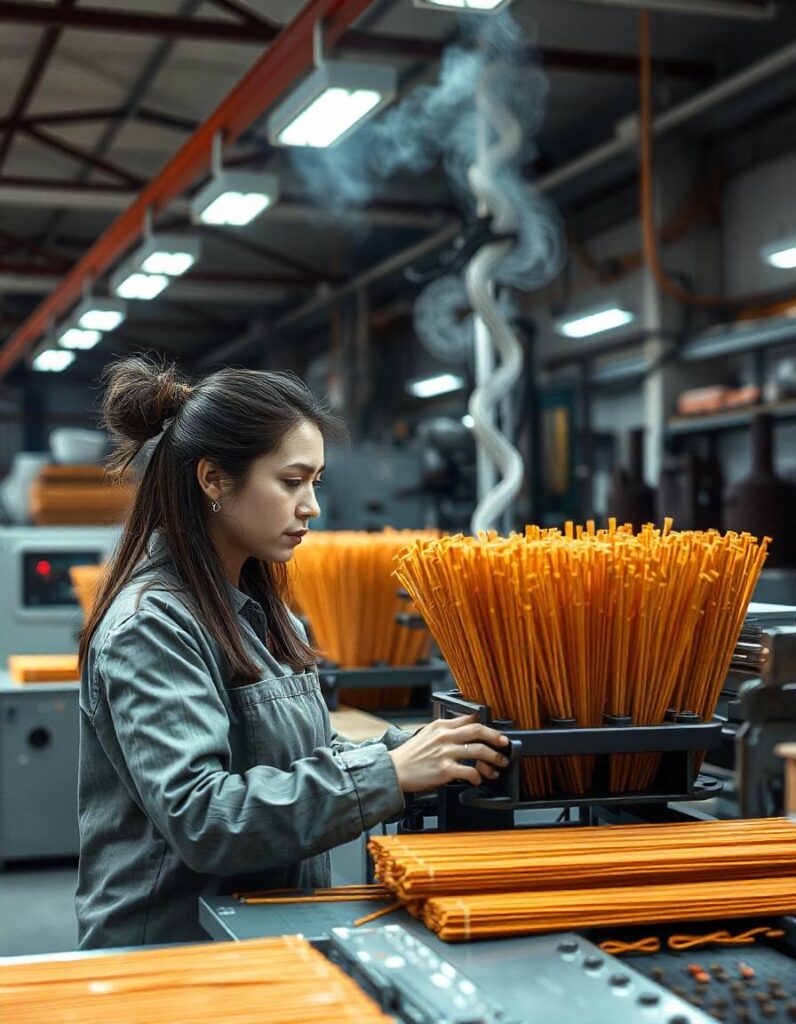The agarbatti (incense stick) manufacturing industry is one of the most lucrative small-scale businesses in India. This article provides a detailed guide covering raw material availability, costs, machinery requirements, transportation expenditure, space requirements, total expenses, marketing strategies, profitability, and government subsidies regarding agarbatti manufacturing industry. Additionally, we’ll include links to machinery and raw material suppliers and explore the differences between semi-automatic and fully automatic machinery of agarbatti making.
Raw Material Availability and Cost
Essential Raw Materials
-
- Bamboo Sticks: The base of the incense stick, typically sourced from Assam, Tripura, or imported from Vietnam and China.
-
- Wood Powder: Used for binding, available from sawmills.
-
- Charcoal Powder: Ensures even burning, obtained from local markets.
-
- Jigat Powder: A binding agent derived from bark.
-
- Essential Oils and Fragrances: Includes sandalwood, rose, jasmine, and lavender oils, sourced from fragrance suppliers.
-
- Dyes (optional): For colored incense sticks.
-
- Packaging Materials: Plastic wraps, cardboard boxes, and branding labels.
Raw Material Costs
| Material | Cost (per kg) | Monthly Requirement (Small Unit) | Monthly Cost (INR) |
|---|---|---|---|
| Bamboo Sticks | 100-150 | 100 kg | 10,000 – 15,000 |
| Wood Powder | 10-15 | 200 kg | 2,000 – 3,000 |
| Charcoal Powder | 20-25 | 100 kg | 2,000 – 2,500 |
| Jigat Powder | 40-60 | 50 kg | 2,000 – 3,000 |
| Fragrances & Oils | 800-1,500 | 2-5 liters | 1,600 – 7,500 |
| Packaging Material | 2,000 – 5,000 | – | 2,000 – 5,000 |
| Total | – | – | 19,600 – 36,000 |
Machinery: Semi-Automatic vs. Fully Automatic
Semi-Automatic Machinery

-
- Cost: INR 50,000 – 1,00,000
-
- Production Capacity: 5-10 kg/hour
-
- Power Requirement: 1-2 kW
-
- Advantages: Lower initial investment, easy to operate.
-
- Disadvantages: Labor-intensive.
Fully Automatic Machinery
-
- Cost: INR 1,50,000 – 3,00,000
-
- Production Capacity: 10-25 kg/hour
-
- Power Requirement: 3-5 kW
-
- Advantages: Higher production capacity, less labor required.
-
- Disadvantages: Higher initial investment.
Transportation Expenditure
Transportation costs depend on the location of suppliers and customers. On average:
-
- Raw Material Transport: INR 2,000 – 5,000 per month
-
- Finished Product Delivery: INR 3,000 – 7,000 per month (local distribution)
Space Requirements
A small manufacturing unit requires approximately 500-1,000 sq. ft. space:
-
- Raw Material Storage: 200 sq. ft.
-
- Machinery Area: 200 sq. ft.
-
- Packaging & Finished Goods: 100-200 sq. ft.
Monthly rent (urban areas): INR 5,000 – 15,000
Total Expenditure (Monthly)
| Expense | Cost (INR) |
| Raw Materials | 19,600 – 36,000 |
| Machinery (EMI/lease) | 5,000 – 10,000 |
| Labor (5 workers) | 40,000 – 50,000 |
| Rent | 5,000 – 15,000 |
| Utilities (Electricity) | 3,000 – 7,000 |
| Transportation | 5,000 – 10,000 |
| Total | 77,600 – 1,28,000 |
Agarbatti Marketing and Selling
Target Customers
-
- Retailers and wholesalers
-
- Religious organizations and temples
-
- Export markets (demand in the USA, Europe, Middle East)
-
- E-commerce platforms (Amazon, Flipkart)
Marketing Strategies
-
- Local Distributors: Partner with small shops and regional distributors.
-
- Online Presence: List products on platforms like Amazon and Flipkart.
-
- Social Media Advertising: Use Facebook and Instagram ads.
-
- Exhibitions and Fairs: Participate in trade fairs for exposure.
Profitability in agarbatti manufacturing business:
-
- Production: 100 kg/day
-
- Selling Price: INR 150/kg
-
- Monthly Revenue: INR 4,50,000 (based on 25 working days)
-
- Monthly Profit: Revenue – Expenditure = INR 3,22,400 (approx.)
Government Subsidy and Schemes
The Indian government provides support through:
-
- MSME Loan Schemes: Low-interest loans under the PMEGP scheme.
-
- Capital Subsidy: 15-25% subsidy on machinery.
-
- Skill Development Programs: Free training sessions under the Ministry of MSME.
Machinery and Raw Material Suppliers
Machinery Suppliers
-
- Indiamart: www.indiamart.com
-
- TradeIndia: www.tradeindia.com
Raw Material Suppliers
-
- Raw Incense: www.rawincense.com
-
- Amazon Business: www.amazon.in/business
This guide provides a comprehensive roadmap for starting an agarbatti manufacturing business, ensuring you have all the necessary details to begin your entrepreneurial journey. With proper planning and execution, this business can yield significant profits and long-term growth.